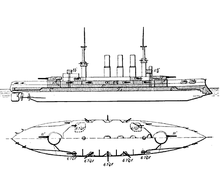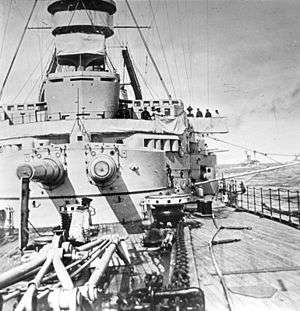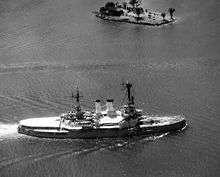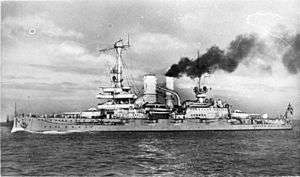Deutschland-class battleship
 Deutschland-class battleships in line.[lower-alpha 1] | |
| Class overview | |
|---|---|
| Builders: | |
| Operators: | |
| Preceded by: | Braunschweig-class battleship |
| Succeeded by: | Nassau-class battleship |
| Built: | 1903–08 |
| In commission: | 1906–45 |
| Completed: | 5 |
| Lost: | 3 |
| Scrapped: | 2 |
| General characteristics | |
| Type: | Pre-dreadnought battleship |
| Displacement: |
|
| Length: | 127.60 m (418 ft 8 in) |
| Beam: | 22.20 m (72 ft 10 in) |
| Draft: | 8.21 m (26 ft 11 in) |
| Installed power: | 17,000 PS (13,000 kW; 17,000 ihp) |
| Propulsion: | three shafts, three triple expansion steam engines, 12 boilers[lower-alpha 2] |
| Speed: | 18.5 knots (34.3 km/h; 21.3 mph) |
| Range: | 4,800 nmi (8,900 km; 5,500 mi); 10 knots (19 km/h; 12 mph) |
| Complement: |
|
| Armament: |
|
| Armor: |
|
The Deutschland class was a group of five pre-dreadnought battleships built for the German Kaiserliche Marine. The class comprised Deutschland, Hannover, Pommern, Schlesien, and Schleswig-Holstein. Built between 1903 and 1908, the ships closely resembled those of the preceding Braunschweig class, though they had stronger armor protection. They were made obsolete before they were even completed by the launch of the revolutionary Royal Navy battleship HMS Dreadnought in 1906. As a result, they were the last ships of that type built for the German Navy. They were followed by the Nassau-class battleships, Germany's first dreadnought battleships.
With the commissioning of the Deutschland class, the fleet had enough battleships to form two full battle squadrons; the fleet was then reorganized into the High Seas Fleet, which saw combat during World War I. Despite their obsolescence, all five of these ships were present at the Battle of Jutland on 31 May – 1 June 1916. In the confused night actions, Pommern was torpedoed and sunk. After the battle, the four surviving ships were removed from the front-line fleet and employed in secondary tasks. The Treaty of Versailles permitted Germany to retain several old battleships for coastal defense, including the four Deutschland-class ships.
However, instead of being used as a coastal defense ship, Deutschland was broken up in 1920–1922. Hannover was to be converted into a target vessel, although this was never done. She was eventually broken up in 1944–1946. Schlesien and Schleswig-Holstein were the only two vessels of the class to see continued front-line service in the Reichsmarine and later the Kriegsmarine. Both ships saw limited duty during World War II, which was inaugurated by the firing of Schleswig-Holstein's main guns at the Polish fortress at Westerplatte. Near the end of the war the two ships were both sunk.
Design
The five Deutschland-class battleships were the last pre-dreadnoughts built by the German Navy. They were similar to the preceding Braunschweig-class ships—Deutschland was nearly identical, though the design was modified slightly after the lead ship was laid down. The four subsequent ships had a somewhat different boiler arrangement and slightly thicker armor compared to the Braunschweig-class ships.[1] All five vessels of the Deutschland class dispensed with the turret mountings for the secondary 17-centimeter (6.7 in) guns; all of these guns were mounted in casemates in the hull. The ships were built despite rumors of the capabilities of the revolutionary HMS Dreadnought then under construction.[2] Admiral Alfred von Tirpitz insisted on their construction, since larger ships would have necessitated widening the Kaiser Wilhelm Canal. This would have put a prohibitive strain on the naval budget for the year.[3]
General characteristics

The Deutschland-class ships were 125.90 m (413 ft 1 in) long at the waterline and 127.60 m (418 ft 8 in) overall. They had a beam of 22.20 m (72 ft 10 in) and a draft of 8.21 m (26 ft 11 in) forward. The ships were designed to displace 13,191 metric tons (12,983 long tons) with a standard load, and displaced up to 14,218 metric tons (13,993 long tons) at full load.[4] The Deutschland-class ships' hulls were built with transverse and longitudinal steel frames. Steel hull plates were riveted to the structure created by the frames. The hull was split into twelve watertight compartments, although Pommern had thirteen compartments. The hull included a double bottom that ran for 84 percent of the length of the ship.[5]
The ships handled less easily than the preceding Braunschweig-class ships, though they suffered less marked weather helm. Their metacentric height was .98 m (3 ft 3 in).[4] The ships' crews numbered 35 officers and 708 enlisted men. When one of them was a squadron flagship, the crew was augmented by 13 officers and 66 enlisted men; while serving as a second command ship, 2 officers and 23 enlisted men were added to her standard crew.[5] After she became a training ship in 1935, Schlesien's crew consisted of 29 officers and 559 enlisted men, plus up to 214 cadets. Schleswig-Holstein differed somewhat; her crew as a training ship numbered 31 officers and 565 men and up to 175 cadets. Deutschland and her sisters carried a number of smaller vessels, including two picket boats, one admiral's barge, two launches, one pinnace, two cutters, two yawls, and two dinghies.[4]
Machinery
Deutschland and her sisters were equipped with three-shaft triple expansion steam engines. The ships had a single rudder and three screw propellers. The two outer propellers were three-bladed, and 4.80 m (15 ft 9 in) in diameter. The center screw had four blades and was 4.50 m (14 ft 9 in) in diameter.[6] Steam was supplied to the engines by twelve marine-type boilers, four for each engine, with the exception of Deutschland.[5] This ship was boilered as in Braunschweig, with eight marine-type boilers and six cylindrical boilers.[6] Deutschland's engines were rated at 16,000 PS (15,781 ihp; 11,768 kW), while the other four ships' engines were rated at 17,000 PS (16,767 ihp; 12,503 kW). The design speed for all of the ships was 18 knots (33 km/h; 21 mph), though on trials all five ships exceeded the figure.[4]
The ships were designed to carry 700 metric tons (690 long tons; 770 short tons) of coal, though additional spaces could be utilized as fuel storage, which increased fuel capacity to 1,540 metric tons (1,520 long tons; 1,700 short tons). This provided a maximum range of 4,800 nautical miles (8,900 km; 5,500 mi) at a cruising speed of 10 knots (19 km/h; 12 mph).[4] Electrical power was supplied from four turbo-generators that supplied 260 kilowatts (350 hp) each at 110 volts.[5]
Armament

The armament of the Deutschland class was nearly identical to that of the preceding Braunschweig class, although it was rearranged slightly and increased in number. The primary armament consisted of four 28 cm (11 in) SK L/40[lower-alpha 4] quick-firing guns in two twin turrets, one forward and one to the rear of the main superstructure. The turrets were the Drh.L. C/01 model, which allowed elevation to 30° and depression to −5°. At maximum elevation, the guns could hit targets out to 18,830 m (20,590 yd). The guns fired 240 kg (530 lb) shells in both high-explosive and armor-piercing (AP) types. Muzzle velocity for both types of shells was 820 m/s (2,690 f/s). At a range of 12,000 m (13,000 yd), the AP shells could penetrate armor plating up to 160 mm (6.3 in) thick.[7]
The secondary battery consisted of fourteen 17 cm (6.7 in) guns mounted in casemates amidships. Five were emplaced in the top deck and two one deck higher in the superstructure on either side. The casemates allowed elevation to 22° and depression to −5°. At 22°, the guns could engage targets 14,500 m (15,900 yd). Each gun was supplied with 130 armor-piercing shells, and fired at a rate of approximately 5 per minute. The guns had an arc of train of 160°.[8]
The ships were armed with twenty-two 8.8 cm (3.5 in) quick-firing guns in single mounts, which were manually operated. The guns fired 15.4 lb (7.0 kg) high-explosive shells at up to 12 rounds per minute.[5][9] They were supplied with 140 shells each. The guns could hit targets out to 11,000 m (12,000 yd).[10]
Armor
The Deutschland-class ships were equipped with Krupp cemented armor.[5] Deutschland had a slightly different arrangement in the belt armor and the citadel in the superstructure. Deutschland's belt was 225 mm (8.9 in) at the waterline and tapered to 140 mm (5.5 in) on the lower edge. Her sister ships' belts was increased in thickness to 240 mm (9.4 in) at the waterline and down to 170 mm (6.7 in) on the bottom edge. In Deutschland, the citadel armor was 160 mm (6.3 in) thick, while on the other four ships the armor was 170 mm thick. All five ships had an armored deck that was 40 mm (1.6 in) thick.[11]
The main battery gun turrets had armored sides that were 280 mm (11 in) thick and roofs that were 50 mm (2.0 in) thick. The barbettes that held the turrets were armored with 250 mm (9.8 in) thick steel. The casemate guns were protected by 35 mm (1.4 in) thick armor plating. Their forward conning towers were protected by 300 mm (12 in) on the sides, while the rear conning towers had 140 mm (5.5 in) worth of armor.[11]
Construction
Deutschland was ordered for the German fleet under the contract designation "N."[lower-alpha 5] She was laid down at the Germaniawerft dockyard in 1903, under construction number 109.[12] She was launched on 20 November 1904; once she left the stocks fitting out work commenced. This included the installation of the ship's armament, completion of the interior compartments, and the finishing of the superstructure. By mid 1906 work on the ship was finished. Deutschland was commissioned into the fleet on 3 August of that year.[13] Hannover was ordered as "O" and laid down at the Kaiserliche Werft Wilhelmshaven in 1904.[12] She was launched on 29 September 1905 and commissioned on 1 October 1907.[13]
Pommern was laid down at the AG Vulcan dockyard in Stettin under the provisional name "P" in 1904.[12] She was launched on 2 December 1905 and commissioned into the fleet on 1 October 1907.[13] In 1904, Schlesien was laid down at the Schichau-Werke in Danzig under the provisional name "R."[12] She was launched on 28 May 1906 and commissioned on 5 May 1908.[13] Schleswig-Holstein was ordered from the Germaniawerft dockyard under the contract name "Q." Her keel was laid there in 1905.[12] Launched on 17 December 1906, Schleswig-Holstein was completed by July 1908 and commissioned on the 6th, the last ship of the five to join the fleet.[13]
Ships
| Ship | Builder | Namesake | Laid down | Launched | Commissioned | Fate |
|---|---|---|---|---|---|---|
| Deutschland | Germaniawerft, Kiel | Germany | 20 June 1903 | 19 November 1904 | 3 August 1906 | Broken up at Wilhelmshaven, 1922 |
| Hannover | Kaiserliche Werft, Wilhelmshaven | Province of Hanover | 7 November 1904 | 29 September 1905 | 1 October 1907 | Broken up at Bremerhaven, 1946 |
| Pommern | AG Vulcan, Stettin | Pomerania | 22 March 1904 | 2 December 1905 | 6 August 1907 | Torpedoed during surface action, 1 June 1916 |
| Schlesien | Schichau-Werke, Danzig | Silesia | 19 November 1904 | 28 May 1906 | 5 May 1908 | Sunk following mine strike at Zinnowitz, 3 May 1945 |
| Schleswig-Holstein | Germaniawerft, Kiel | Schleswig-Holstein | 18 August 1905 | 17 December 1906 | 6 July 1908 | Scuttled following air attack, 21 March 1944 |
Service history
Following their commissioning beginning in 1906, the ships joined the II Battle Squadron of the Heimatflotte (Home Fleet), which also included the Braunschweig-class ships.[3] Deutschland replaced Kaiser Wilhelm II as the flagship of the fleet. Once the II Battle Squadron was complete, the fleet was reorganized as the Hochseeflotte (High Seas Fleet).[14] The five ships conducted several training cruises and fleet maneuvers every year until 1914; these included cruises into the Atlantic Ocean and the Baltic Sea and annual tours of Norway.[15] In 1913, Deutschland was replaced as fleet flagship by the new dreadnought Friedrich der Grosse.[16] The five ships were in Norway for the annual fleet visit in July 1914. The threat of war forced the cruise to be cut short, and all of the ships were back in German ports by the end of the month.[17]
World War I

The ships of the Deutschland class continued to serve in the II Battle Squadron during World War I. The ships conducted patrols in the mouth of the Elbe River in the first weeks of the war while the rest of the fleet was still being mobilized. They also took part in most of the major fleet actions in the first two years of the war. This primarily included acting as a support force for the battlecruisers that bombarded the English coast in the hopes of luring out a portion of the British fleet.[18]
The five ships participated in the Battle of Jutland on 31 May – 1 June 1916 under the command of Admiral von Mauve,[19] where they formed the Second Battle Squadron (the Squadron was completed by a sixth pre-Dreadnought, the Hessen of the Braunschweig class). Towards the end of the fleet battle on the evening of 31 May, the five Deutschland-class ships came to the aid of the mauled battlecruisers of the I Scouting Group. The Deutschlands intervened and prevented the British battlecruisers under Admiral David Beatty from pursuing the German ships.[20] In the darkness, the Germans had difficulty making out their targets and failed to score any hits; the British, however, managed to hit three of the Deutschlands. Pommern was forced briefly to haul out of line.[21] During the night actions, Pommern was torpedoed. The torpedo detonated an ammunition magazine and destroyed the ship, killing all hands on board.[22] The German fleet reached Wilhelmshaven by mid-day of 1 June, where the undamaged dreadnoughts of the Nassau and Helgoland classes took up defensive positions.[23]
By the end of 1916, the four remaining ships were withdrawn from service with the fleet. They were placed into reserve on 15 August 1917. Deutschland and Schleswig-Holstein became barracks ships in Wilhelmshaven and Kiel, respectively. Hannover was used as a guard ship in the Danish belt, and Schlesien became a training ship in Kiel.[3] Guns removed from these ships starting in 1917 were used by the Imperial Army in World War I as railway guns.
Inter-war years

Following the German defeat in World War I, three of the Deutschland-class battleships were allowed to be retained in the German Navy, which was reorganized as the Reichsmarine: Hannover, Schleswig-Holstein and Schlesien, along with several of the Braunschweig-class battleships.[24] Deutschland was instead scrapped in 1922.[13] The three remaining pre-dreadnought battleships were modernized in the 1920s,[25] which included the replacement of the ships' 17 cm guns with 15 cm (5.9 in) pieces.[26]
Hannover was the first of all the old battleships to come in service with the Reichsmarine in February 1921 as fleet flagship in the Baltic. Her first homeport was Swinemünde but she was transferred to Kiel in 1922. In 1923 the German Navy adopted a new command structure and Braunschweig became flagship of the Fleet. In October 1925, Hannover was moved to the North Sea station. She was decommissioned in March 1927 when Schlesien returned to active service. With newly built masts but still three funnels she entered service again replacing Elsass in February 1930 until September 1931.[27]
In 1932, Schleswig-Holstein was re-boilered and converted into a cadet training ship.[28] One of the most significant changes visually was the trunking of the two forward funnels into a single larger smoke stack.[29] Schlesien was made the flagship of the battleship squadron in January 1933.[30] In May 1935, the Reichsmarine was again reorganized as the Kriegsmarine. By this time, only Schlesien and Schleswig-Holstein were still operating as warships; the four Braunschweig-class ships had been disposed of or converted into auxiliary ships.[25]
Hannover was struck from the navy list in 1936 and destined for the scrapyard. There were ideas to rebuilt her as a target ship especially for aircraft, although this never occurred. Schlesien was re-boilered and converted into a training ship as well in 1936.[28] The following year, Schlesien toured South America, including a stop in Argentina in December.[31] By 1939, both ships had been replaced in front-line service by newer ships, and were instead relegated to training duties.[32][lower-alpha 6]
World War II

In August 1939, Schleswig-Holstein conducted what was purported to be a ceremonial tour of the Baltic to commemorate the sinking of the light cruiser SMS Magdeburg in August 1914. At the conclusion of the tour, the ship was towed into the port of Danzig opposite the Polish military depot at Westerplatte. At 04:47 on 1 September, Schleswig-Holstein fired the first shots of World War II, when she opened fire on the base in Westerplatte.[33] A detachment of marines then stormed the fortress, which resisted for seven days. Throughout the battle, Schleswig-Holstein provided artillery support. During the operation Schlesien remained in her training ship role, though she briefly acted as an icebreaker for U-boats.[34]
Schleswig-Holstein and Schlesien then participated in the occupation of Denmark and invasion of Norway, respectively, in April 1940. Afterward, Schleswig-Holstein was again removed from front-line service and used as a training ship, while Schlesien resumed her ice-breaking duties. In March 1941, Schlesien escorted mine-layers in the Baltic. After returning from this operation, she became a barracks ship in Gotenhafen.[34]
In mid-1944, Schlesien's and Schleswig-Holstein's anti-aircraft armament was considerably strengthened to allow them to be used as an air defense ships in the port of Gotenhafen. Schleswig-Holstein was attacked by RAF bombers in December 1944, and although she was sunk in shallow water, her weapons could still be used. After a fire permanently disabled the ship, her crew was sent ashore to assist in the defense of Marienburg.[34] Starting in 1944, Hannover was broken up for scrap; work lasted until 1945.[28] Schlesien provided fire support for German troops in the vicinity of Gotenhafen between 15 and 21 March 1945.[35] In April, Schlesien was moved to Swinemünde to restock her ammunition supply as well as evacuate 1,000 wounded soldiers from the front. On 3 May she struck a mine outside Swinemünde; the following day she was scuttled by her crew in shallow water. Both ships were broken up in situ after the war.[36]
Footnotes
Notes
- ↑ The five nearest vessels are the Deutschland-class ships.
- ↑ These figures are for the four later ships; Deutschland had a slightly different powerplant that produced 16,000 PS (16,000 ihp; 12,000 kW), though her speed remained the same.
- ↑ Figure for the four later ships; Deutschland's belt armor was only up to 225 mm (8.9 in) thick.
- ↑ In Imperial German Navy gun nomenclature, "SK" (Schnelladekanone) denotes that the gun is quick loading, while the L/40 denotes the length of the gun. In this case, the L/40 gun is 40 caliber, meaning that the gun is 40 times long as it is in diameter.
- ↑ German warships were ordered under provisional names; new additions to the fleet were given letter designations, while those that were intended to replace older vessels were given "Ersatz (name of the ship to be replaced)".
- ↑ The German navy began a construction program under the Nazi regime which included the Deutschland-class cruisers and the Scharnhorst-class battleships and culminated in the Bismarck-class battleships. These ships were all built to replace the old pre-dreadnoughts in German service. See: Williamson, p. 6 and Gröner, pp. 31, 33, and 60.
Citations
- ↑ Staff, p. 5.
- ↑ Hore, p. 69.
- 1 2 3 Gardiner & Gray, p. 141.
- 1 2 3 4 5 Gröner, p. 21.
- 1 2 3 4 5 6 Gröner, p. 20.
- 1 2 Gröner, pp. 18–20.
- ↑ Gardiner & Gray, p. 140.
- 1 2 Staff, p. 6.
- 1 2 3 4 5 Gröner, pp. 20–21.
- 1 2 3 4 5 6 Gröner, p. 22.
- ↑ Herwig, p. 45.
- ↑ Staff, p. 8–15.
- ↑ Staff, p. 10.
- ↑ Staff, p. 11.
- ↑ Staff, pp. 10–15.
- ↑ Tarrant, p. 286.
- ↑ Tarrant, p. 195.
- ↑ London, p. 71.
- ↑ London, p. 89.
- ↑ Tarrant, p. 263.
- ↑ Williamson, pp. 5–6.
- 1 2 Williamson, p. 6.
- ↑ Proceedings, p. 1014.
- ↑ Hildebrand, p. 47 f, Vol. 3.
- 1 2 3 Gardiner & Chesneau, p. 222.
- ↑ Miller, p. 99.
- ↑ Mueller, p. 89.
- ↑ Newton, p. 184.
- ↑ Williamson, p. 7.
- ↑ Williamson, pp. 7–8.
- 1 2 3 Williamson, p. 8.
- ↑ Rohwer, p. 398.
- ↑ Gardiner & Gray, pp. 141–142.
References
- Gardiner, Robert; Gray, Randal, eds. (1985). Conway's All the World's Fighting Ships, 1906–1921. Annapolis: Naval Institute Press. ISBN 978-0-87021-907-8.
- Gardiner, Robert; Chesneau, Roger; Kolesnik, Eugene M., eds. (1979). Conway's All the World's Fighting Ships: 1860–1905. London: Conway Maritime Press. ISBN 978-0-85177-133-5.
- Gardiner, Robert; Chesneau, Roger, eds. (1980). Conway's All the World's Fighting Ships, 1922–1946. Annapolis: Naval Institute Press. ISBN 978-0-87021-913-9.
- Gröner, Erich (1990). Jung, Dieter; Maass, Martin, eds. German Warships: 1815–1945. Annapolis: Naval Institute Press. ISBN 978-0-87021-790-6.
- Herwig, Holger (1998) [1980]. "Luxury" Fleet: The Imperial German Navy 1888–1918. Amherst: Humanity Books. ISBN 978-1-57392-286-9.
- Hildebrand, Hans H. (1979 ff). Die deutschen Kriegsschiffe: Biographien – ein Spiegel der Marinegeschichte von 1815 bis zur Gegenwart. Herford: Koehlers Verlagsgesellschaft. Check date values in:
|date=(help) - Hore, Peter (2006). The Ironclads. London: Southwater Publishing. ISBN 978-1-84476-299-6.
- London, Charles (2000). Jutland 1916: Clash of the Dreadnoughts. Oxford: Osprey Publishing. ISBN 978-1-85532-992-8.
- Miller, David (2001). Illustrated Directory of Warships of the World. Zenith Imprint. ISBN 978-0-7603-1127-1.
- Mueller, Michael (2007). Canaris: The Life and Death of Hitler's Spymaster. Annapolis: Naval Institute Press. ISBN 978-1-59114-101-3.
- Newton, Ronald C. (1992). The "Nazi Menace" in Argentina, 1931–1947. Stanford: Stanford University Press. ISBN 978-0-8047-1929-2.
- Rohwer, Jürgen (2005). Chronology of the War at Sea, 1939–1945: The Naval History of World War Two (Third revised ed.). Annapolis: US Naval Institute Press. ISBN 978-1-59114-119-8.
- Staff, Gary (2010). German Battleships: 1914–1918 (1). Oxford: Osprey Books. ISBN 978-1-84603-467-1.
- Tarrant, V. E. (2001) [1995]. Jutland: The German Perspective. London: Cassell Military Paperbacks. ISBN 978-0-304-35848-9.
- Williamson, Gordon (2003). German Battleships 1939–45. Oxford: Osprey Publishing. ISBN 978-1-84176-498-6.
- "German Naval Notes". Proceedings. Annapolis: United States Naval Institute. 48: 1014–1015. 1922.
Online sources
- DiGiulian, Tony (25 March 2009). "Germany 28 cm/40 (11") SK L/40". NavWeaps.com. Retrieved 3 April 2010.
- DiGiulian, Tony (28 March 2010). "Germany 17 cm/40 (6.75") SK L/40". NavWeaps.com. Retrieved 3 April 2010.
- DiGiulian, Tony (29 October 2006). "German 8.8 cm/35 (3.46") SK L/35". NavWeaps.com. Retrieved 3 April 2010.
Further reading
- Dodson, Aidan (2014). "Last of the Line: The German Battleships of the Braunschweig and Deutschland Classes". Warship 2014. London: Conway Maritime Press: 49–69. ISBN 978-1591149231.
![]() Media related to Category:Deutschland class battleship at Wikimedia Commons
Media related to Category:Deutschland class battleship at Wikimedia Commons